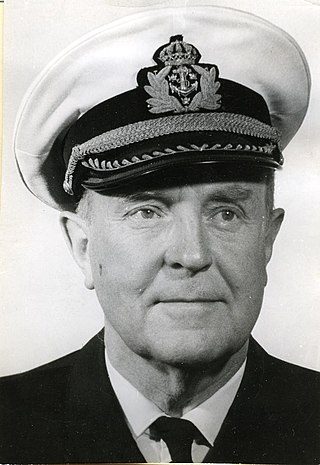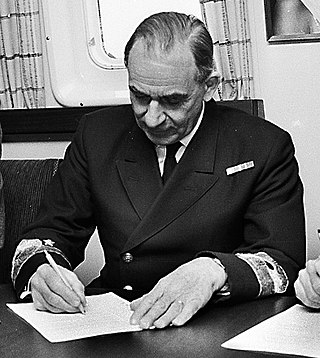
Admiral Bengt Gustaf Gottfrid Lundvall was a senior Swedish Navy officer. He was Chief of the Navy from 1970 to 1978.

Vice Admiral Erik Magnus Anderberg was a Swedish Navy officer. He is famous for being the grand architect of the notion of a unified Swedish signal intelligence authority. Anderberg served as captain of the HSwMS Sverige from 1940-1941, commander of the Royal Swedish Naval Staff College from 1943 to 1945, Chief of the Naval Staff from 1945 to 1950 and as commanding officer of the East Coast Naval District from 1951 to 1957.

Rear Admiral Bengt Göran Rasin, né Larsson was a Swedish Navy officer. His senior commands include Commander-in-Chief of the Coastal Fleet, commanding officer of the West Coast Military Command and commanding officer of the Western Military District. Rasin also served as chairman of the Royal Swedish Society of Naval Sciences.

Captain Nils Harry Martin Bong was a Swedish Navy officer. Bong served as commanding officers of the torpedo boat HSwMS Antares, the cruisers HSwMS Örnen and HSwMS Tre Kronor, and the coastal defence ship HSwMS Oscar II. He also served as commanding officer of the Gothenburg Squadron and of the Karlskrona Naval Training Schools.

Vice Admiral Erik Viktor Philip Gustafsson af Klint was a Swedish Navy naval officer. af Klint's senior commands include postings as Chief of Staff of the Coastal Fleet, head of Section 2 of the Defence Staff, Commander-in-Chief of the Coastal Fleet and commanding officer of the Naval Command East.

Vice Admiral Carl Holger Holter Henning was a Swedish Navy officer. Henning served as Chief of the Military Office of the Ministry of Defence from 1961 to 1970.

Nils Ivar (Nils-Ivar) Carlborg was a Swedish Army officer. He started the paratrooper training in Sweden and founded the Swedish Army Paratroop School of which he was its first commander (1952–1953). He later served as head of the Military Academy Karlberg (1964–1969) and as commander of Stockholm Defence District (1969–1973) and as the Commandant of Stockholm (1969–1973).

Rear Admiral Rolf Sigurdsson Rheborg was a Swedish Navy officer. Rheborg served as head of the Royal Swedish Naval Academy (1969–1971), as head of Section 3 in the Naval Staff (1971–1973) and as Chief of Staff of the Southern Military District (1973–1978) in Kristianstad.

Rear Admiral Sten Gustaf Ivar Swedlund was a Swedish Navy officer. Swedlund's senior commands include as commander of the South Coast Naval Base from 1987 to 1990 and Commander-in-Chief of the Coastal Fleet from 1990 to 1994. After retiring from the military, Swedlund became involved in the Red Cross's international aid activities in Yugoslavia, North Korea and Iraq during the Iraq War.

Rear Admiral Sören Christer Douglas Kierkegaard was a Swedish Navy officer. Swedlund's senior commands include as Commander-in-Chief of the Coastal Fleet from 1970 to 1977 and commander of the East Coast Naval Base from 1977 to 1983.

Rear Admiral Stig Olof Bergelin was a Swedish Navy officer. Bergelin captained both destroyers and cruisers as well as the 1st Destroyer Division and the 2nd Squadron. He also headed the Navy Schools at Berga from 1956 to 1958, Karlskrona Naval Yard from 1960 to 1961, and served as acting commanding officer of the Naval Command South in Karlskrona from 1963 to 1966. Furthermore, Bergelin was chairman of the Royal Swedish Society of Naval Sciences from 1963 to 1966. He was murdered in central Karlskrona by a mentally ill person in 1983.

Rear Admiral Gunnar Emil Grandin was a Swedish Navy officer. Grandin's career in the Swedish Navy began in 1940 when he graduated from the Royal Swedish Naval Academy. Over the years, he rose through the ranks, serving on coastal defence ships and minesweepers. By 1965, he had attained the rank of captain. In his later career, Grandin played a crucial role in the development and procurement of naval equipment and systems for the Swedish Navy. He helped transition Sweden from relying on foreign naval electronics to achieving self-sufficiency in this area. This collaboration extended to other Nordic countries, especially Denmark and Norway, resulting in cost-sharing for various projects and more efficient production.
The Consulate General of Sweden, Houston was the diplomatic mission of Sweden in Houston between 1963 and 1981. The consulate general originated from the consulate opened in 1950, which was converted into a consulate general in 1963. The consulate general tasks was to advance the interests of Sweden, and to serve and protect Swedes in Houston and different states in the Southern United States. Along with those in Chicago, Minneapolis, New York City, San Francisco, and Montreal, the consulate general belonged to the so-called "heritage consulates" due to the large number of inheritance cases it handled.
The Consulate General of Sweden, Montreal was the diplomatic mission of Sweden in Montreal between 1916 and 1993. The consulate general originated from the consulate opened in 1906, which was converted into a consulate general in 1916. The consulate general tasks was to advance the interests of Sweden, and to serve and protect Swedes in Montreal and in different provinces and territories of Canada. Along with those in Chicago, Houston, Minneapolis, New York City, and San Francisco, the consulate general belonged to the so-called "heritage consulates" due to the large number of inheritance cases it handled.












